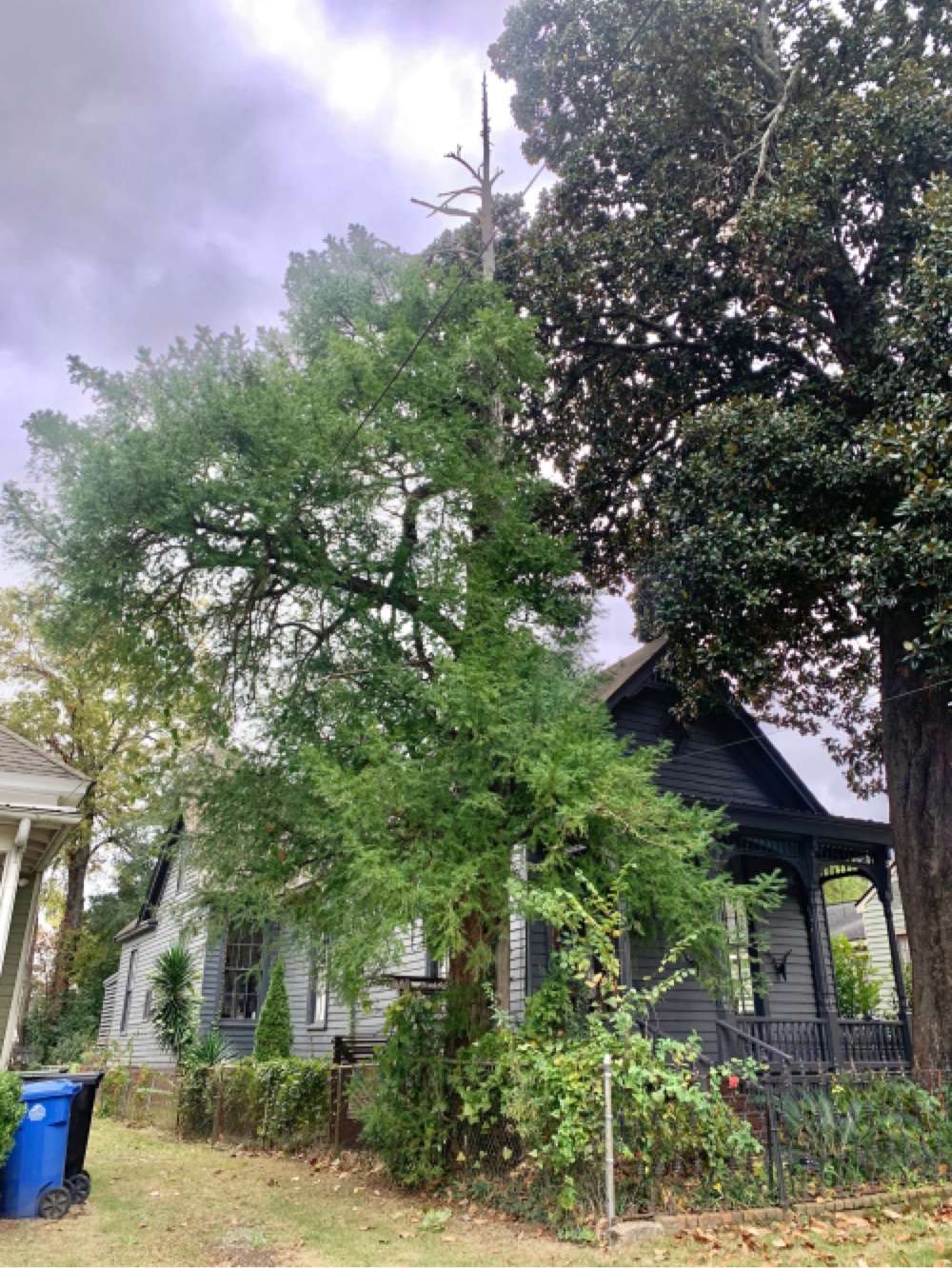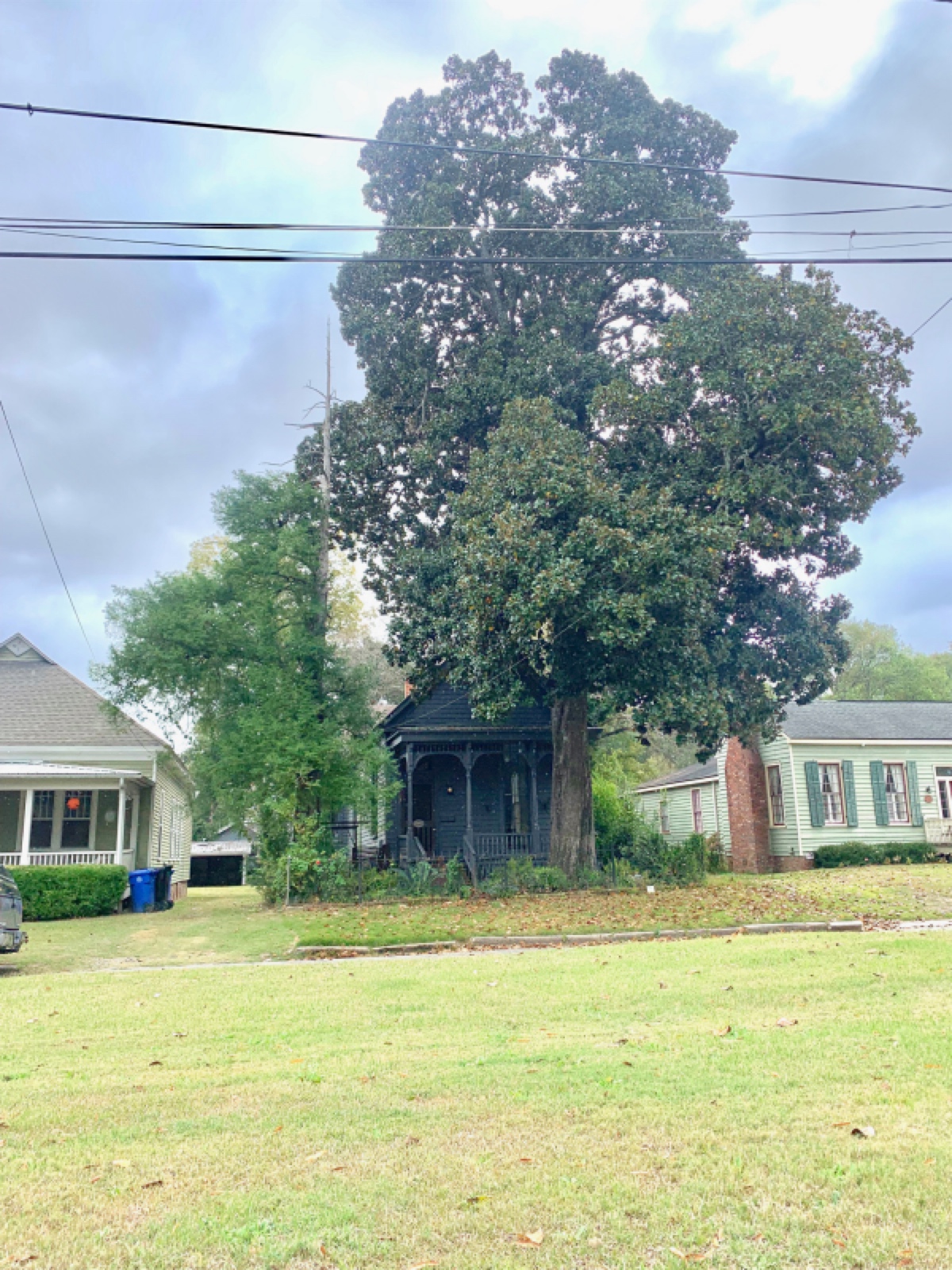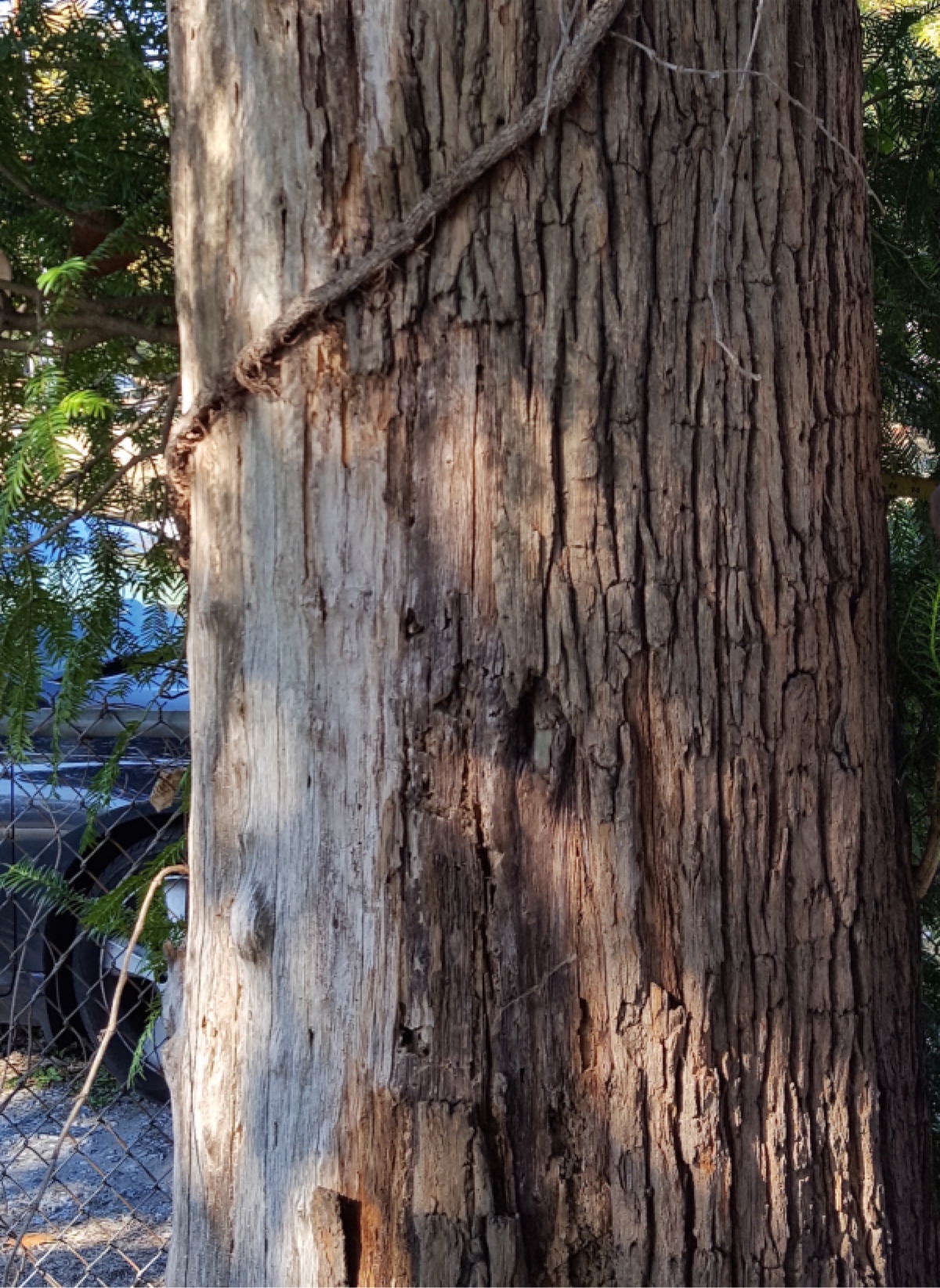|
Oldest living Torreya taxifolia is in Columbus, Georgia
October 2025 photos by Dijon Guite.
ABOVE: Two front-yard trees at this home in Columbus, Georgia, are only about a hundred yards from the Chattahoochee River. Florida torreya is at left, and the huge southern magnolia at right. As you scroll down to previous years, you will see this lone torreya has the lightning-struck dead top for as far back as photos go. Earlier photos are of a pair of torreyas at a nearby house rather than of this smaller torreya, and both have long been removed.
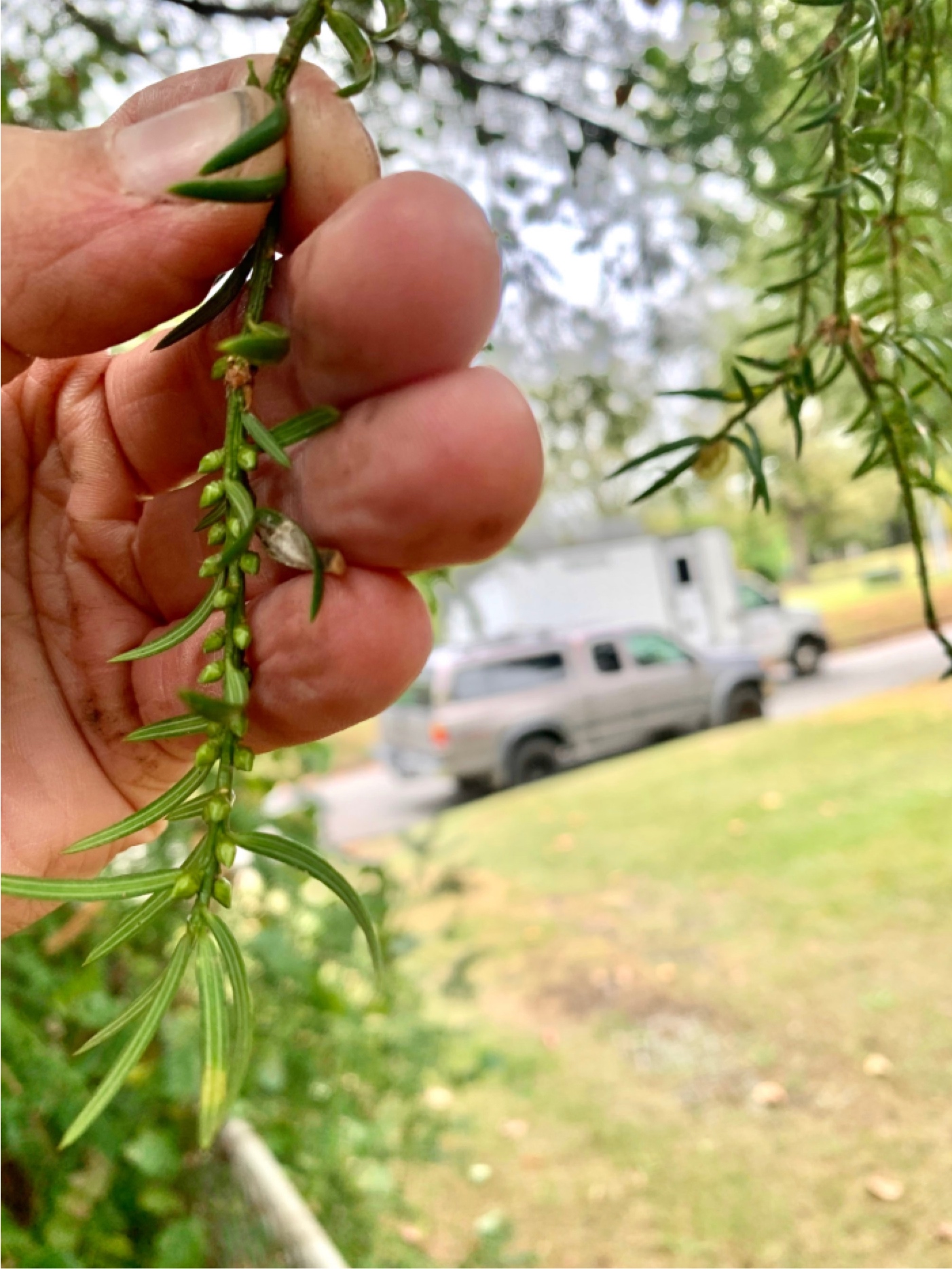 |
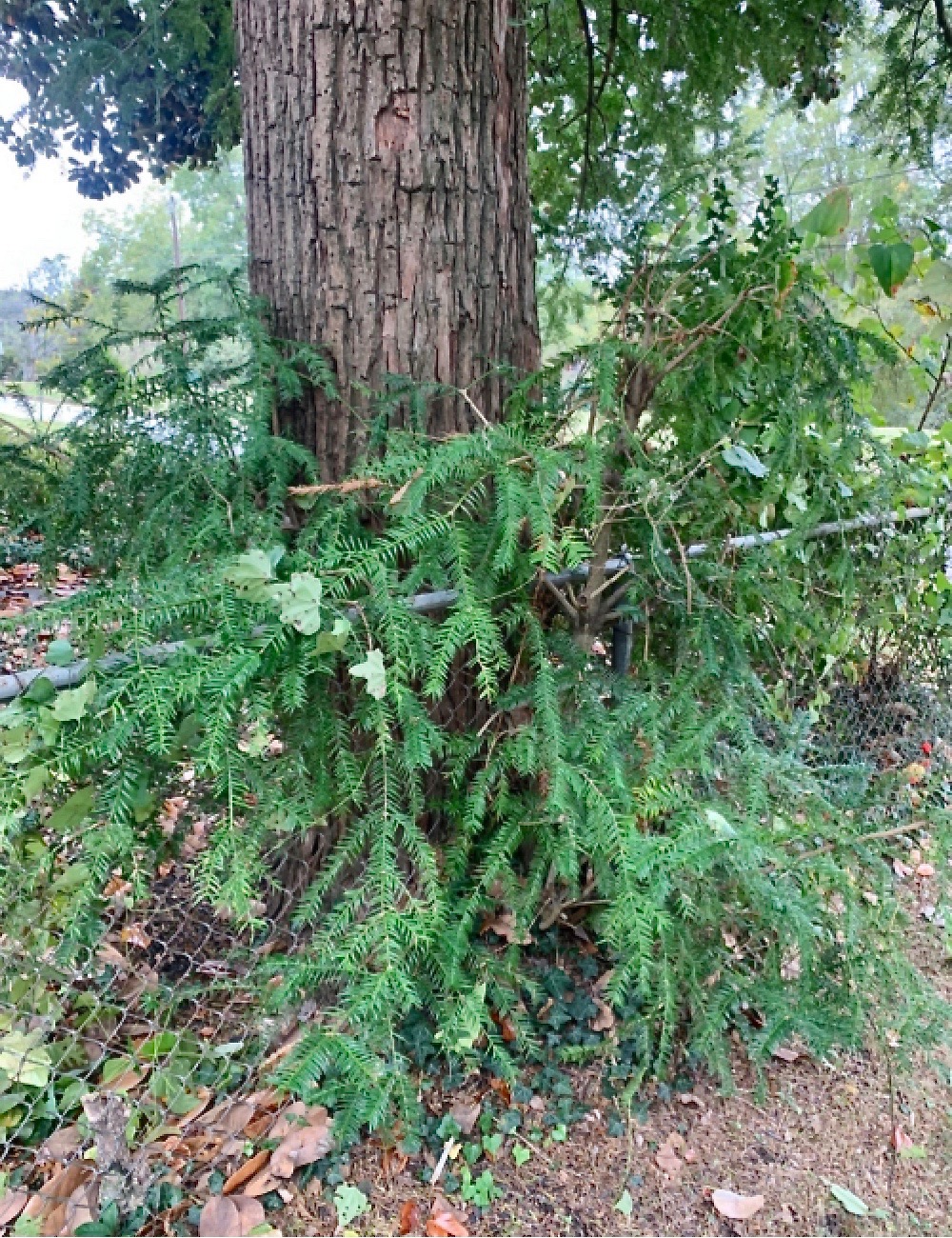 |
|
LEFT: A lower branch of multiple pollen buds confirms this tree is male.
CENTER: Dijon obtained permission from the owner to collect portions of these vegetal sprouts for Clint Bancroft to root into shrubs of the same genetics. The two tallest at the back left of the trunk are clearly apical growth forms. But the ones growing over the fence are strange. Are they perhaps lower branches that the tree would have sent out right along the ground into the open, sunny area? See examples of such ground-lying branches.
|
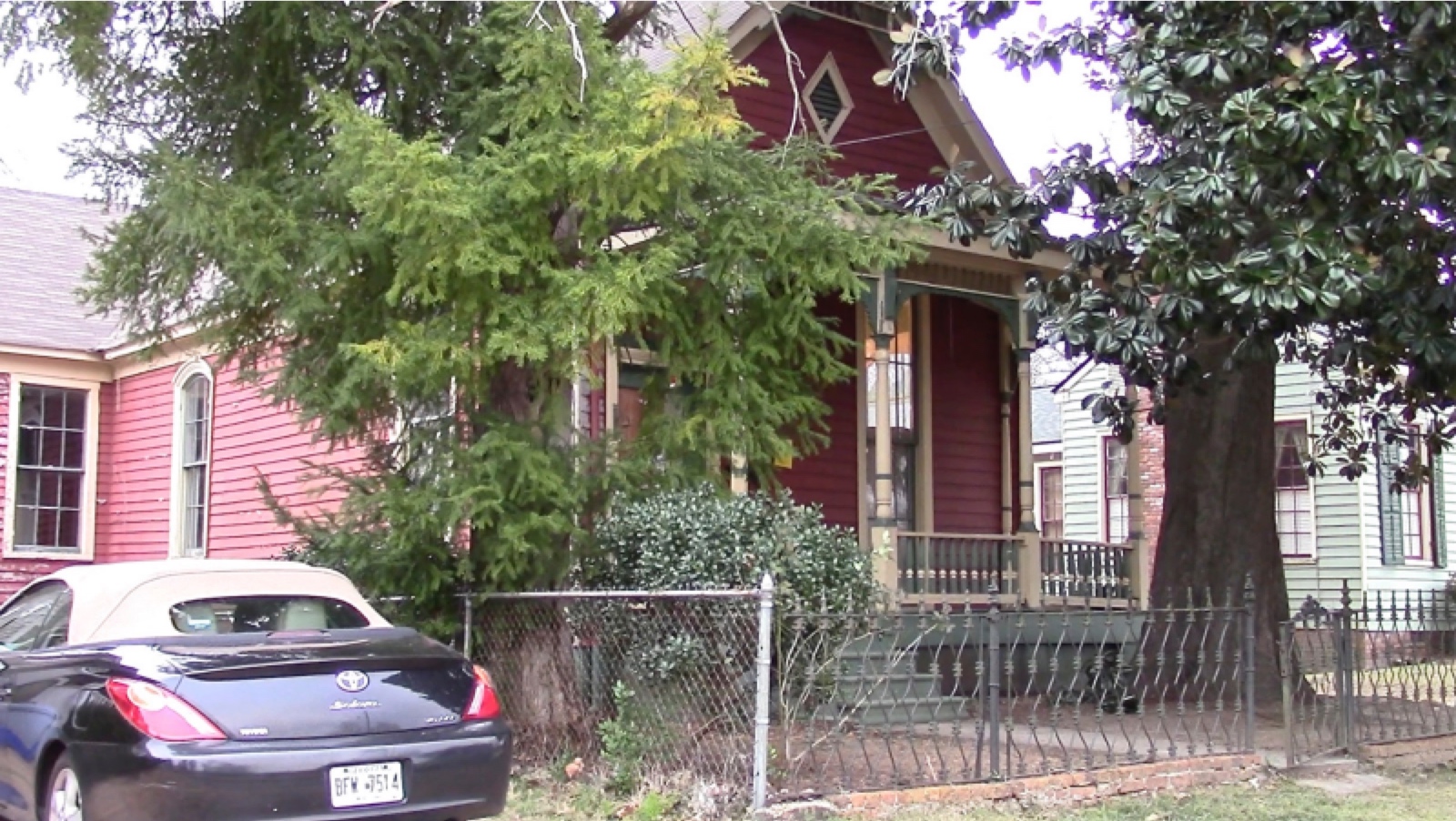
ABOVE: 2015 photo by Connie Barlow of Torreya on the left and a Southern Magnolia on the right.
LOCATION: 538 Front Avenue, Columbus GA
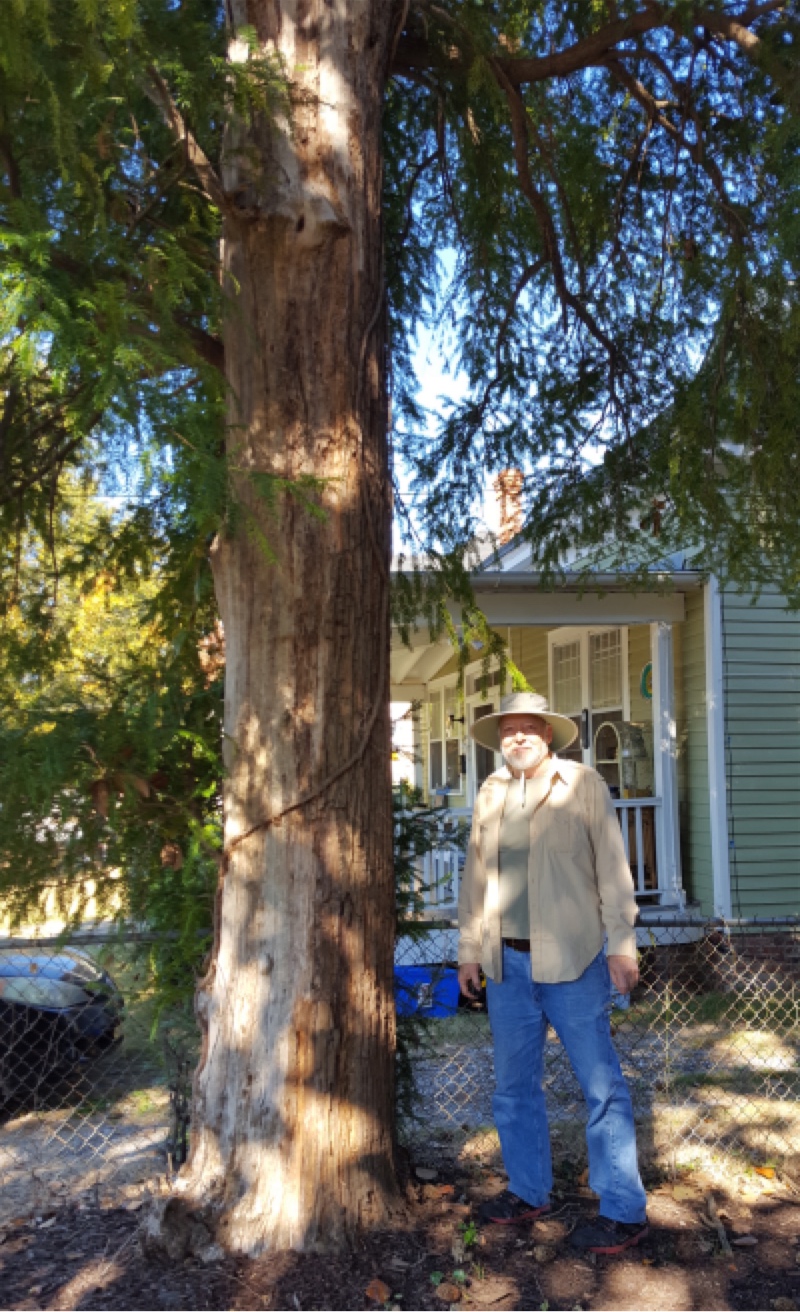 |
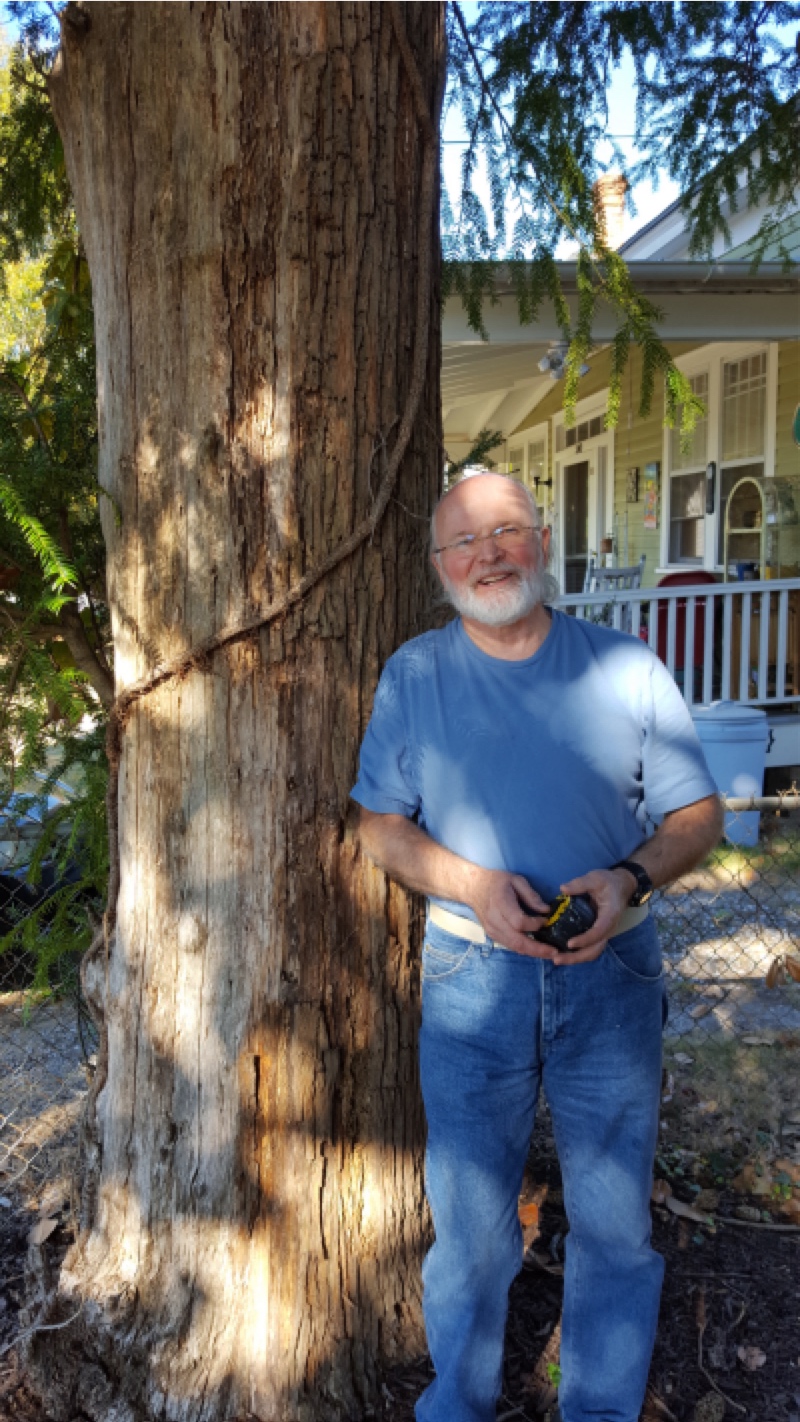 |
|
Columbus, GA is on the east bank of a free-flowing section of the Chattahoochee River, and until the first decade of the 21st century, three old torreya trees were still found on residential properties in a historically old neighborhood that bordered the river. As of 2016, only one of the three trees still stands. Its top is dead and a huge section of lower bark has been stripped away on the street-side of the tree.
In November 2016, Torreya Guardians Jack Johnston (far left) and Clint Bancroft (left) made a pilgrimage to measure the tree and take small cuttings from branches in order to preserve the genetics of this ancient tree (cloning via rooting the branchlets).
The left-most photo shows the dense leafiness of the tall basals that emerge only on the opposite side of the tree.
|
CONNIE BARLOW summarizes:
Very little information is available on this exceptional tree (and the two nearby that recently were removed by the homeowners). So questions remain: Were they planted from nursery stock, or were they originals that the old homes were built near? If the latter, had there also been wild specimens along this section of river, but the remaining trees were felled for their valuable wood before anyone recorded their presence (as natives) here? These questions are crucial, because the Chattahoochee River would have been the key conduit for southward displacement of this large-seeded species from the s. Appalachians during peak glacial times of the Pleistocene. Likely, the river itself floated seeds from the Appalachian Mountains all the way to the Apalachicola final refuge.
UPDATE 30 OCTOBER 2016
On Oct 30, 2016, at 8:09 PM, Clint wrote:
"I recently wrote to the owner of the Columbus Torreya requesting permission to get cuttings from his tree and got a call from him today. I had despaired of hearing anything back, since I mailed my letter over two weeks ago. He had just returned to Columbus today and said he called me immediately upon reading my letter. I asked him if he is artistic since what he has done to the house since buying it strongly suggested so. He simply said, "Yes, I'm a painter". Turns out he is a known artist, very successful, and lives between Columbus, New York, and Florida. He grew up in Phenix City, AL, right across the river and went to college in Columbus. His brother lives in Columbus. His wife is a very successful set designer for the likes of Madonna. His name is Mike Howard and he is on the internet which is how I found about his and his wife's particulars.
"Anyway, he was very nice and said we are welcome to come take cuttings, which Jack Johnston says should ideally be done in November. I have put Jack on notice but have not heard back from him yet. The owner was aware of his tree's fame and also told me that one of the three original Columbus Torreyas was located in the yard to the right of his house. Although healthy, it was cut down a few years ago by the person who bought the house. I believe that to be more information than we have previously known about where it was located and what happened to it. He did say they did not grind the stump, so I will check to see if it possibly has resprouted when I travel down there."
UPDATE 28 SEPT 2017: Clint Bancroft reports that of 3 propagators of the branchlets cut in 2016, only his have rooted and stayed alive. He grew his "under domes":
"It appears I have had success with the Columbus, Georgia cuttings. Not 100% survived but it appears many did. Jack Johnston lost all of his portion, as did Nearly Native Nursery in Fayetteville, GA. I don't know what technique was tried in Fayetteville, but Jack tried rooting his in plastic bags. I grew mine under domes, and kept some outdoors and some indoors the first Winter. I did try a few in a sealed container (not unlike a plastic bag) and lost ALL of that bunch after they had survived the Winter (these were kept indoors in an unheated room) and had even put on new growth in Spring, but then all turned brown within days of each other and suffered what we (in Anesthesia) used to call "severe death". So maybe trying to root them in sealed containers is not a good option. It appears so."
UPDATE 11 OCTOBER 2017: Clint Bancroft reports:
"I previously wrote you about Jack Johnston's having lost all of his cuttings from the Torreya in Columbus, GA. Jack had put his cuttings in pots sealed in zip lock bags. I, on the other hand, appear to have had success with all the Columbus tree cuttings that I kept under domes (cloches). I lost all of the ones I put into pots, using the same medium as the ones under domes, and putting the pots into a sealed plastic storage box (essentially like a zip lock bag).
"I told you that Jim, at Nearly Native Nursery in Fayetteville, GA, had also received Columbus cuttings from us. I knew from Jack Johnston that all Jim's cuttings had died, but at the time I wrote you I did not know how Jim had handled his cuttings. Today I saw him for the first time since we gave him the cuttings last November. I asked him how he had handled his Columbus cuttings and he said, "I followed Jack's lead and put them in zip lock bags!" Of course this proves nothing (or does it?) but it seems that rooting cuttings in sealed bags (or sealed plastic storage boxes in my case) yields negative results. My guess is that while the cutting itself needs continual high humidity, the soil needs exposure to fresh air. Using the dome technique the soil around the dome is exposed to ambient air whereas with the sealed techniques the soil is not exposed to fresh air or movement of air. I tried rooting a bunch of round leaf birch cuttings this summer and used zip lock bags since I was out of domes. I lost every single cutting."
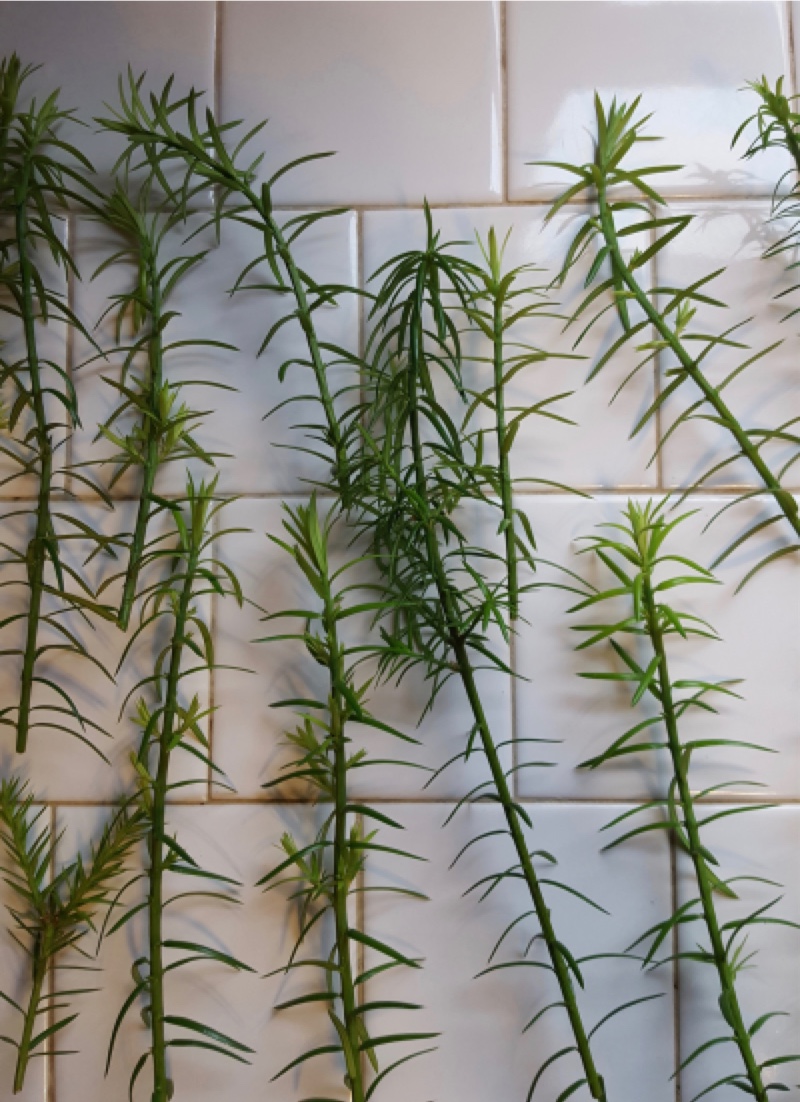 |
|
20 FEBRUARY 2018: CLINT BANCROFT reports:
"The original Columbus cuttings are rooted and Jack Johnston said "they look fabulous". I have made 2 more trips through Columbus and took more cuttings in Dec. 2017 and Feb. 2018. The big tree there still looks healthy in spite of its many scars."
26 SEPTEMBER 2019: Clint Bancroft reports:
"The first Columbus cuttings Jack and I collected in October several years ago have not done well at all. Jack and Jim (Mail Order Natives) lost all of theirs. I had them to root and look good until spring whereupon most died. I still have maybe 3 of that batch left. Not a one has put on any new growth in, I believe, 3 years. Maybe October is not an optimal time but that was only an isolated instance."
PHOTO LEFT: 16 SEPTEMBER 2019: Clint Bancroft reports:
"The 16 apicals I got from my last Columbus trip seem to be doing very well. And as we learned from the Highlands apical cutttings, they continue to grow with radial symmetry! ... The Columbus cuttings in the picture were carried home in no particular position in a zip lock bag, refrigerated overnight, and by the next morning each one was under a cloche. They were not kept in an upright position during transport but were vertical within 24 hours. The way they look in the photo (left) was how they looked when cut." |
4 OCTOBER 2019 UPDATE: Clint writes, "One, and only one, of the last cuttings I got from Columbus wilted at the tip after it was stuck. I kept all the cuttings indoors. They are still indoors. I moved the wilted one into deeper shade (indoors) and it slowly perked up and eventually rooted.
MARCH 2024 UPDATE: The youtube video I posted of this tree has proved very useful for having folks provide updates. Given the lightning-caused damage to one side of bark, plus the top, it is amazing this tree is still judged "healthy". Here are two youtube comments:
• July 2021: "I was just here today (14 July 2021) to see the tree. Quite healthy looking. Thanks for the info here. This was an exciting observation for me."
• March 2024: "Just checked it out today looks great."
What About the Two Previous Trees?
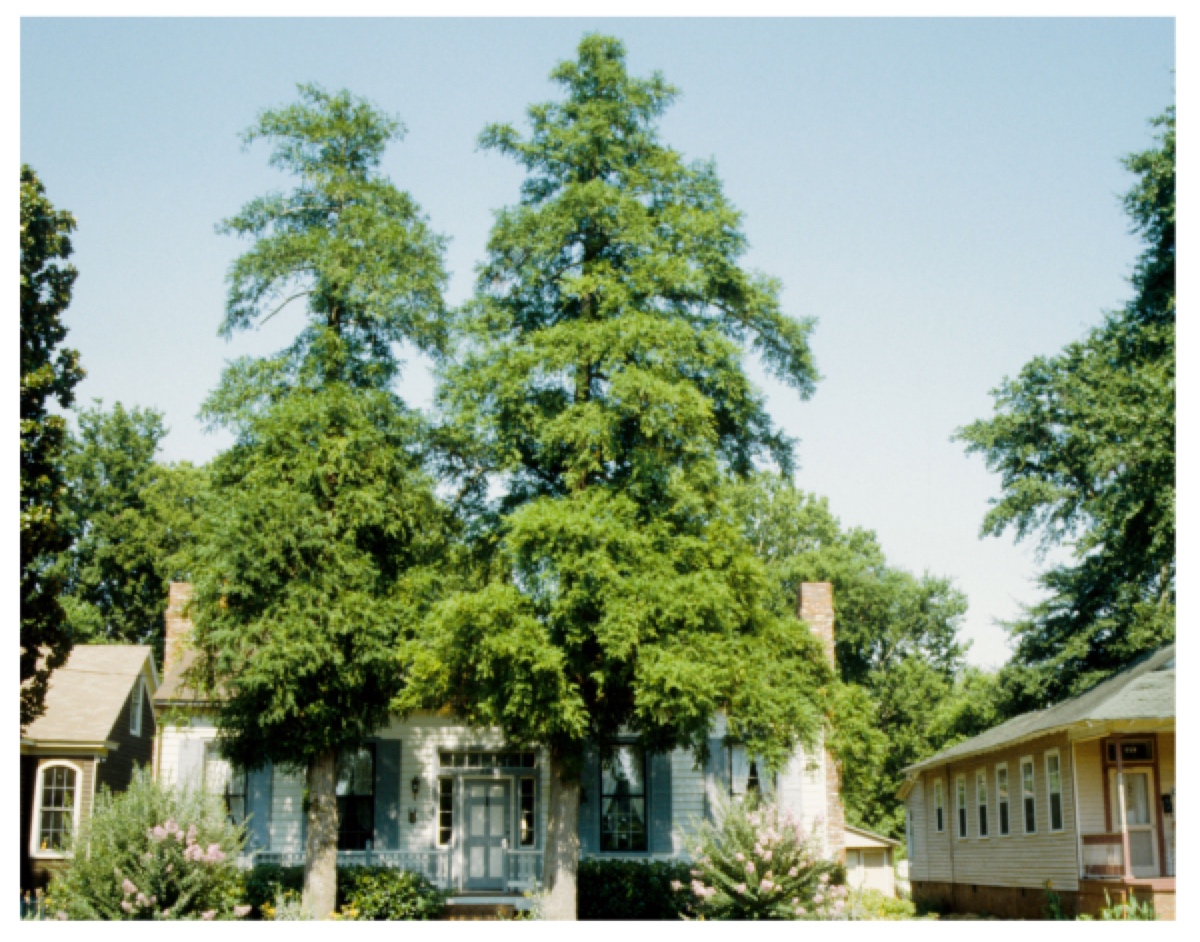 |
|
APRIL 2017:
Dr. Kim Coder (Warnell School of Forestry and Natural Resources, University of Georgia) published a richly-illustrated pdf of Torreya taxifolia in Columbus, GA. The photo left is captioned, "Male and female trees
side-by-side in historic residential neighborhood."
Torreya Guardians is seeking more information from Dr. Coder on the exact locale and date of the photo, as these specimens are shown in front of a different house than the specimen we have visited several times (which has a large Southern Magnolia in the right front position).
UPDATE 2020 by Connie Barlow - Arnold Arboretum shows the addresses of the branchlets cut by Nicholson as: 1168-89*N1 Arnold Arboretum tree/536 and 538 Front Street, Columbus, GA/Dr. Ed Croom/dead on database
|
• 27 May 2017 RESPONSE FROM KIM CODER:
"... I visited these two trees (one male and one female) many times over many years — every time I was in Columbus. I received permission to come onto the property from an older lady at the house where these trees were growing. This lady stated she owned several houses in the area and liked collecting botanical specimens. She invited me to come onto the property and take close-ups. The original photos I took of the two trees began in about 1988 and continued until roughly 1995, I think. The DNR - State Botanist, Tom Patrick, was with me on several occasions, and he may also have photos. I believe these trees faced the river side park in the front yard of the house next door to the lone tree you mention in your newsletter. I have some photos of that tree also somewhere in my files. Those photos are of poor quality due to their aging film base and poor light conditions around that tree. [Later] I was told these trees were damaged by a house fire and were declining. I was then told new property owners removed the remnants of these two trees. I have no way to verify these stories or when events occurred. These were beautiful trees and both showed good vegetative and reproductive growth. The other reproducing trees of which I know are at Cashiers, NC and on the Biltmore House grounds in Asheville, NC. I did not attempt to reproduce these trees, only to highlight their plight within their native range and celebrate specimen trees outside their native range."
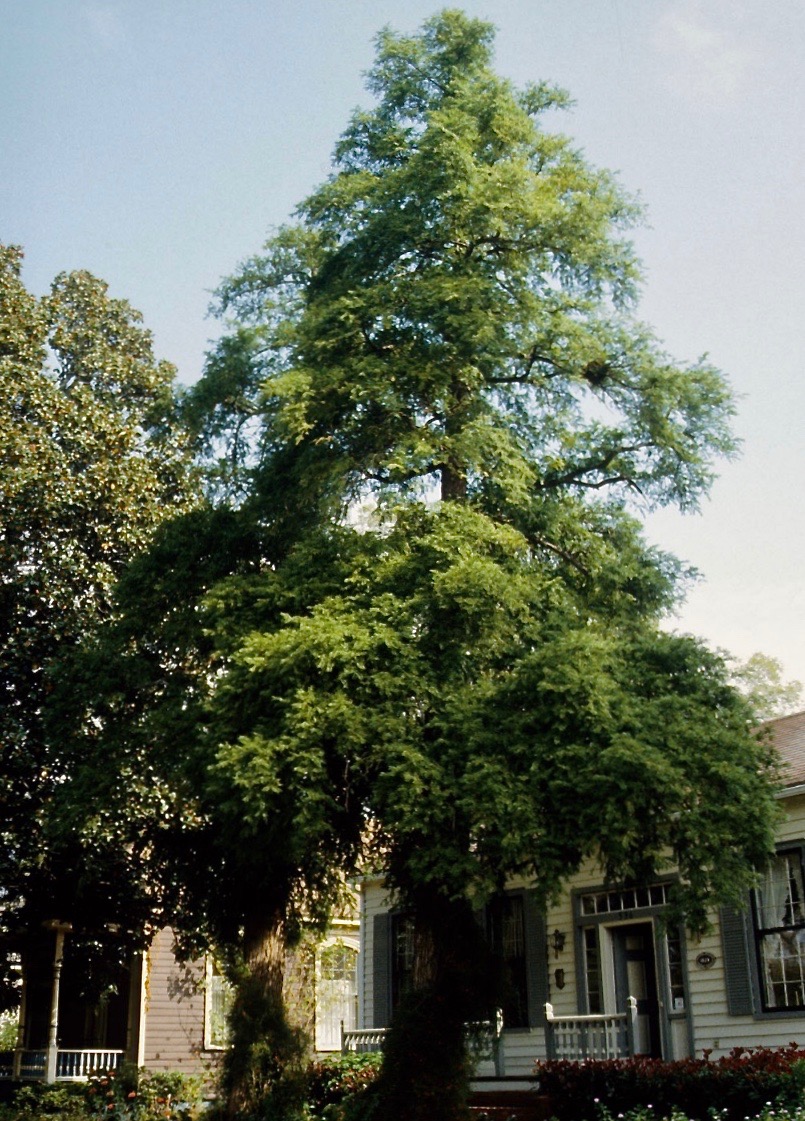 |
|
PHOTO: Connie Barlow writes, "This photo appears in the Torreya webpage by Dr. Kim Coder. Notice the dark brown house with white porch fence. That is indeed the home where I filmed a lone torreya tree during my visit in 2015 (scroll down to see my photos). The S. Magnolia I filmed at that house is also visible (a bit of its canopy) in this photo. So, it appears that the torreya on the left side of the walkway was cut down first, as this is surely the right-most tree."
• May 29, 2017 - CLINT BANCROFT summarizes results:
"There is no longer any doubt; another question has been answered. After seeing the photographs Dr. Coder produced, I can tell you that Jack and I DID find the stumps of the two Columbus Torreyas that have been cut down.
"They were perfectly positioned on each side of the walkway into the house next to the house with the existing tree.
"I recognize both houses in Coder's pictures. Unfortunately, the stumps were rotting with no basal sprouts when Jack and I located them. Now we can be sure that those stumps were the other two cut-down Torreyas. (The stumps of the Torreyas are visible on the google maps street view on the house next to the living Columbus tree.)"
|
CLINT BANCROFT continues: "We thus know that all three of the Columbus Torreyas were originally growing very close together. This would not be unusual for wild trees which grew there before the founding of Columbus, as have been suggested by some. However, the linear relation of the trees to each other and equidistant from the street, indicate they were far more likely to have been intentionally planted there. All three trees were arranged in a straight line running north to south in front of the houses and parallel to the street out front. Perhaps there is someone out there with more pieces to the puzzle. It seems every time we think we have exhausted all leads relative to the Columbus trees, a new tidbit of information turns up."
• 2015 S. SWINEY, a history buff in Columbus GA, posted this comment on Connie Barlow's 2015 youtube video on the Columbus GA tree:
2015 COMMENT BY S. SWINEY - "I would like to share my understanding of the history of the area where this tree is growing. I think it might provide some information that would help in your determination of the age of the tree. The house you find there now as well as those surrounding it are generally dating from the 1880 - 1890's and are, for the most part, second generation structures for that part of the City. They were constructed by the merchant class who made their living in retail commerce and shipping. Columbus, being on the fall line of the Chattahoochee, was the major steamboat locus for west central Georgia and east central Alabama almost from the founding of Columbus in 1828. There was a significant steamboat manufacturing and maintenance operation that took place along the river just around the bend in the river north of where you stood next to the cannons. This boat yard was active both before, during and after the Civil War. The Confederacy built Steam Rams and Gunboats here during the war and two of them are on display at the Civil War Naval Museum here in Columbus. Those cannon on display there are said to be the remains of a battery that was placed in that area to protect the river approaches to the heavy industry located along the River to the north.
"The area surrounding the location of this tree would have been on the edge of an industrial area before and prior to the Civil War and, in fact, the Union Calvary swept through Columbus at the end of the war and burned many of the mills and factories that supported the Confederate war effort. Two gunboats were burned by the Confederates to keep them from Union hands just a short distance down river from where you were standing. This tree would have been standing in the battle area if it were here at that time. After the War, Columbus recovered quickly and became a manufacturing center for textiles and iron goods because of the power provided by the river's drop at the fall line. The Steamboat trade between Columbus and Apalachicola was heavy with manufactured goods and produce going south and retail goods coming north. If I were to be a betting man, I would bet that this tree and its two destroyed companions came north as saplings on a steamboat to decorate the yards of the merchant class families who built these houses along the river as their middle class success allowed them to do so. I think they could have been brought here anytime between 1892 and the early 20th Century when this neighborhood was in its heyday. I make no claim to be an expert on the growth of Columbus or its riverfront. I'm just an amateur history buff who became enthralled with the history of the Chattahoochee. I may very well be wrong but I thought I would place this before you for your consideration."
• 2021 PAUL CAMIRE reports from his online history research:
"I found a letter in a 1846 Horticulturist magazine article from COLUMBUS, GA! The best part is that this Torreya from Columbus is not the ones we are familiar with! However, I believe our current Columbus tree is tied to this one. This [online record of a Torreya] was also the most symmetrical and well-developed Torreya taxifolia that I have ever seen. I found out that this tree was in the garden on the peach plantation of a R.J. Moses. I looked up R.J. Moses and found out he was a plantation owner that had the first successful shipping of Georgia Peaches to the north (New York, etc). He practiced law in Pensacola and Appalachicola, FL.
So 13 years after Croom discovers Torreya, Raphael Moses has a specimen growing in Columbus, GA on his peach plantation...and the writer of the letter collected four dried-up seeds from it and shipped them north. Interestingly, the area where his plantation was located is in the Bennington Hills area of South Columbus, not near the existing specimen. I found out that he was buried in a family plot cemetery on the plantation and title is in the woods near the address 10 Kent Ct., Columbus, GA. A dead-end road has a trail going to the cemetery. The area is all houses now, but it is heavily wooded and the Torreya(s) may exist in the area.
So if Clint ever gets around the area again, it might be an interesting side-trip to take a look around. I don't think the house exists, but maybe some plants escaped from the garden? I can't report that the surviving Columbus tree came from R.J. Moses, or his Torreya, but the evidence seems to tie in together. Maybe Mr. Moses inspired another gardener or gifted a few to some friends?"
EVIDENCE THAT THE 3 COLUMBUS TREES WERE HORTICULTURAL PLANTINGS
SUPPORTS GLACIAL RELICT HYPOTHESIS
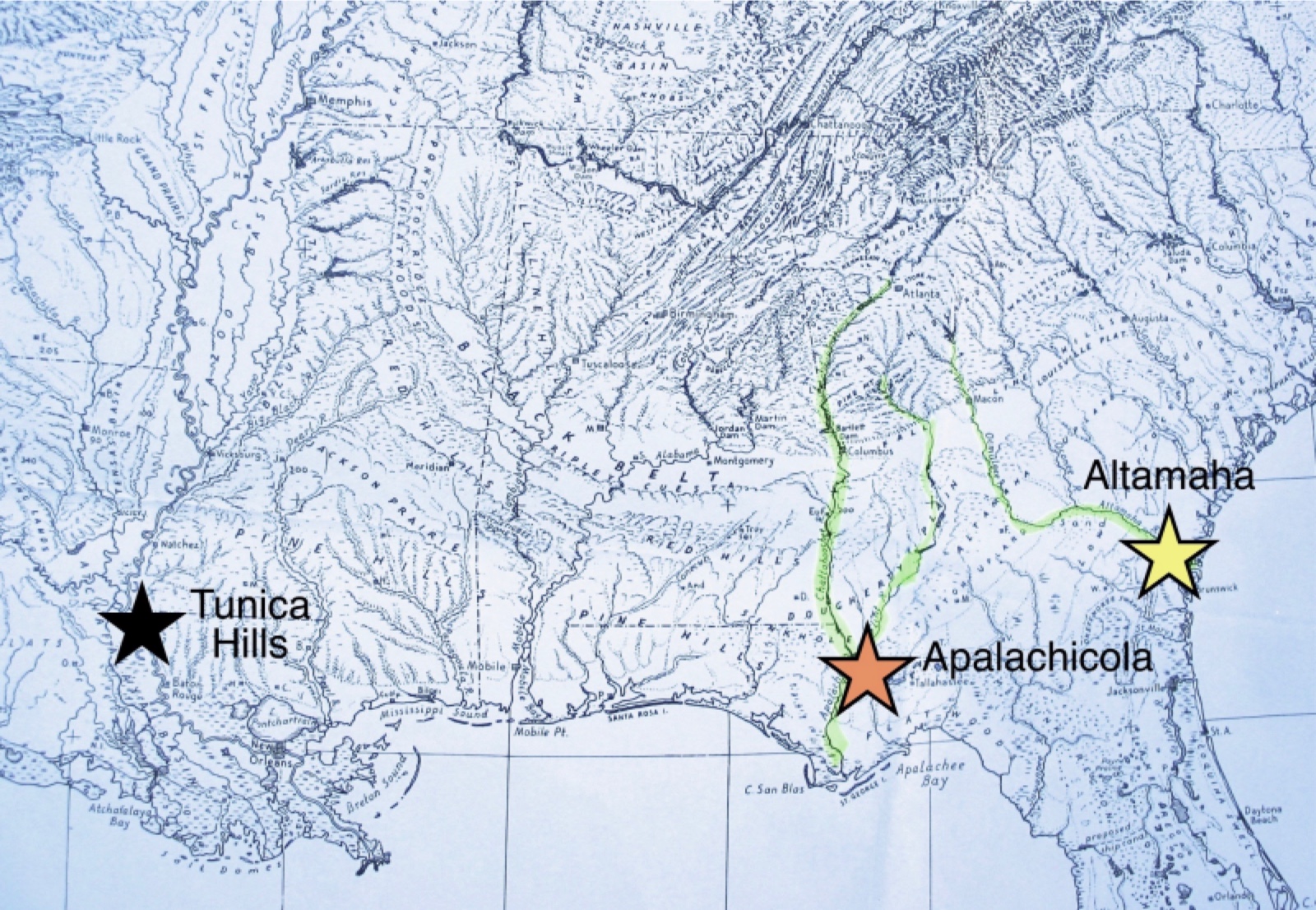
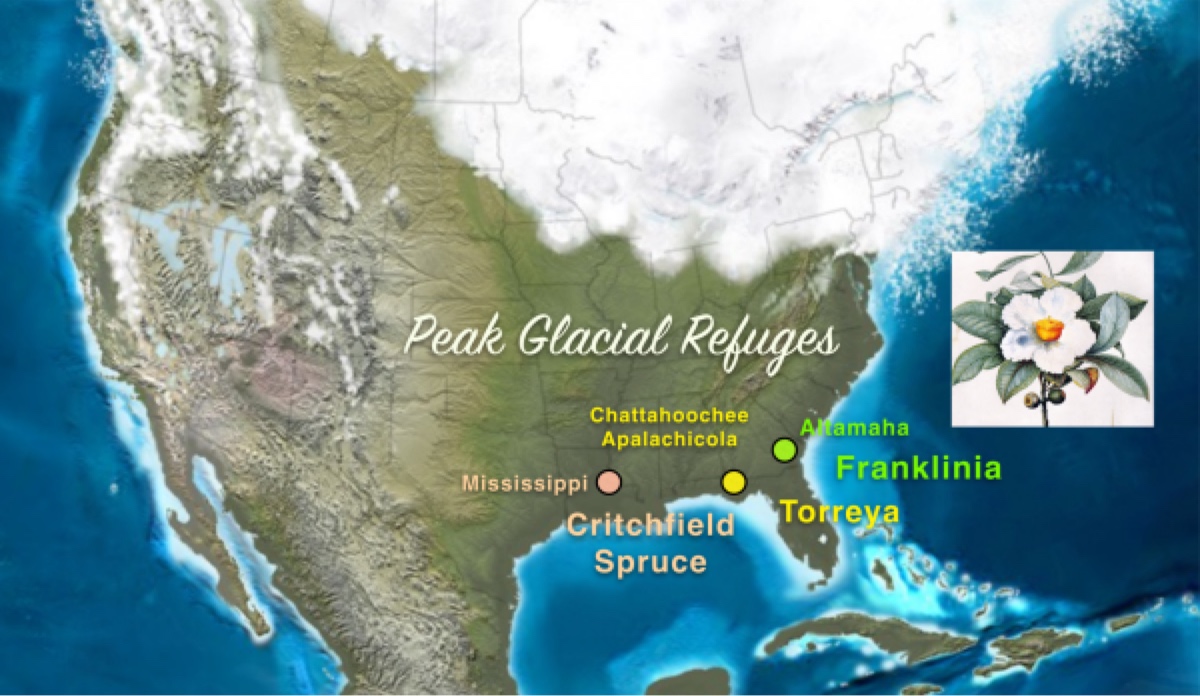
Evidence documented in the TWO COMMENTS immediately above (May 29, 2017 by Clint Bancroft and 2015 by S. Swiney) strongly supports an extreme glacial relictual hypothesis for the tiny native range of Florida Torreya. For context, the two images above illustrate crucial aspects of the GEOGRAPHY of the southeastern USA — specifically, direction and distance of major river flows and locations of the three most well-studied "peak glacial refuges" along the coasts. Long ago, Torreya Guardians became aware of the FLOATING CAPACITY OF THE LARGE SEED, with subsequent experimentation by Clint Bancroft showing that "floaters" have no less capacity than "sinkers" to germinate. These topics are covered in more detail on our webpage that focuses on the PALEOECOLOGY OF FLORIDA TORREYA. But here is an excerpt re the now-leading hypothesis:
EXCERPT: ... 7B. An alternative hypothesis is that the large-seed of Torreya (which is sometimes capable of floating for several days) easily caught a fast and obstacle-free river ride southward from the Appalachian Mountains by way of the Chattahoochee River at the onset of cooling during the Pliocene or Pleistocene. But there was no river-flow way to return north during any of the interglacial warmings. In the first half of the 20th century, the add-on of human-caused warming finally surmounted the physiological threshold of genus Torreya, and it was no longer able to ward off more than a half-dozen native diseases. The fact that the Florida Yew, Taxus floridana is also a subcanopy rare endemic limited to the same relictual range as Florida Torreya suggests that river-flow assistance may truly be limiting. After all, the seed of Florida Yew is bird-dispersed; dispersal by birds offers faster and greater long-distance distribution than can squirrels or tortoises.
OBTAINING VERTICAL GROWTH FROM A CUT BRANCHLET
Owing to questions that Connie Barlow posed to the group in November 2016 about whether one could manipulate a rooted cutting to eventuate in a normal-growth tall tree, a new area of exploration has opened. Jack and Clint collected branchlets only from the basal sprouts — and some of those cuttings would have been terminal growth (hence predisposed to grow in a normal, vertical tree pattern, rather than the shrubby horizontal, "plagiotropic" growth normally resulting from rooted branchlets). Their goal was to obtain cuttings for plagiotropic growth, as that is the best way to have reproductive structures emerge earliest. When working primarily to ensure genetic continuation of an important tree, rooted branchlets endowed with the horizontal predisposition are ideal. If, however, one wants to attempt to produce an actual tree, extra work will be necessary.
JEFF MORRIS has had the most success thus far in producing vertical growth from cut lateral branchlets. He wrote, "The method used in the greenhouse that worked for me was to stake it with a metal tree stake for the season, and when there was no doubt as to the health of the root system, I carefully transplanted it into a new pot. Two seasons of this, and I achieve an upright growth for two T.taxifolias. A third tree was not predisposed to this type of transplanting due to advanced growth of the root system that would have resulted in damage. But if it's less than 4 years since rooted, you'll probably have some success."
U.S. FOREST SERVICE colleagues concurred with Jeff, in part: "In our collective view, if taken care of properly (tie the tops up, trim laterals) and conscientiously, they should forget that they're branches in 4-5 yrs and grow 'right'. So, just relax and go along with the flow. (but really, our collective view is to tell them to get seedlings!)"
FRANK CALLAHAN in Oregon wrote: "The prime representative answer to your question can be resolved by observing the two Torreya taxifolia specimens located in Hawthorn Park, Medford, Oregon. Although both of these trees were rooted from lateral cuttings, there is presently a plethora of vertical growth emanating from the lateral branches, which if rooted will result in plants that will eventually become trees. The same is true for redwoods, capture and root vertical cuttings from lateral branches and those terminal cuttings will eventually become "normal" growth trees."
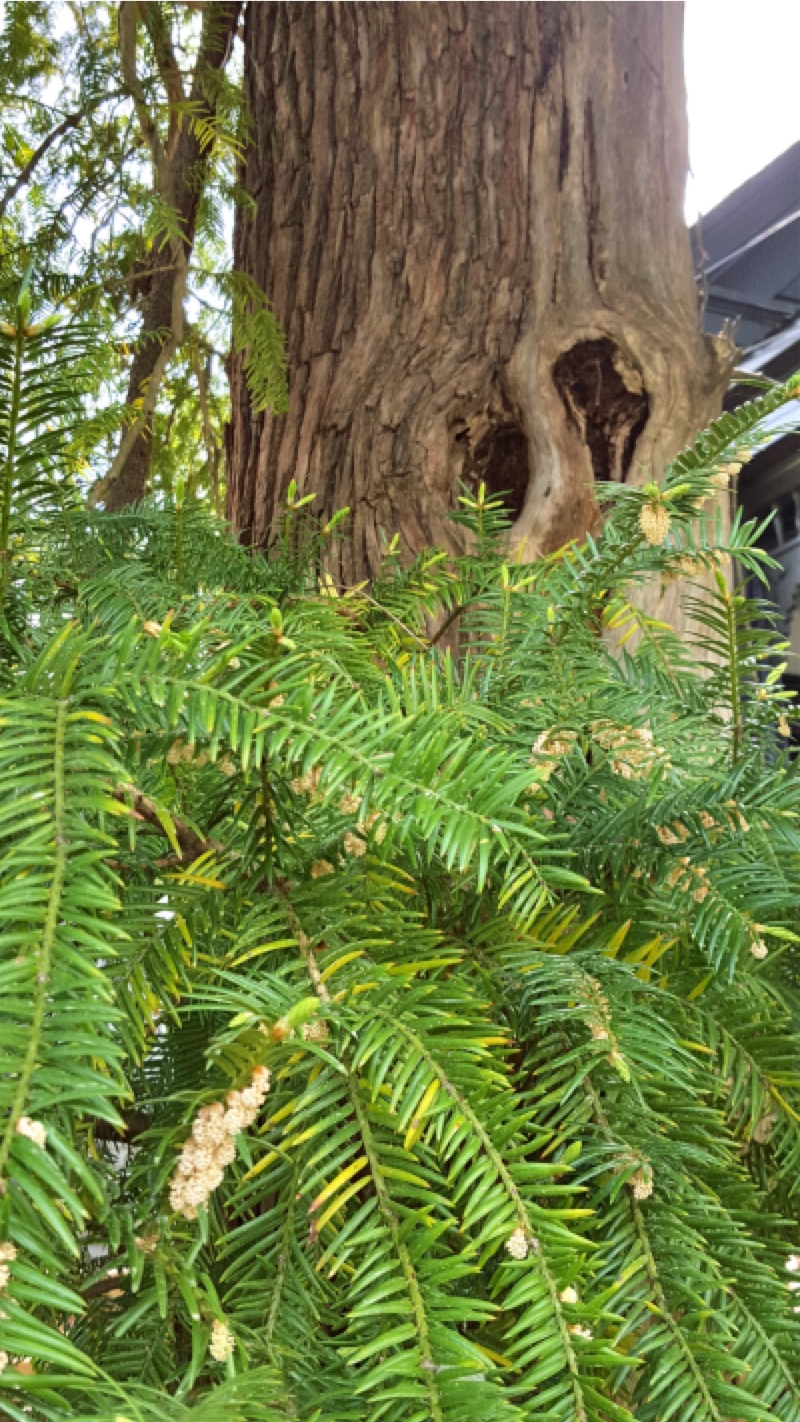
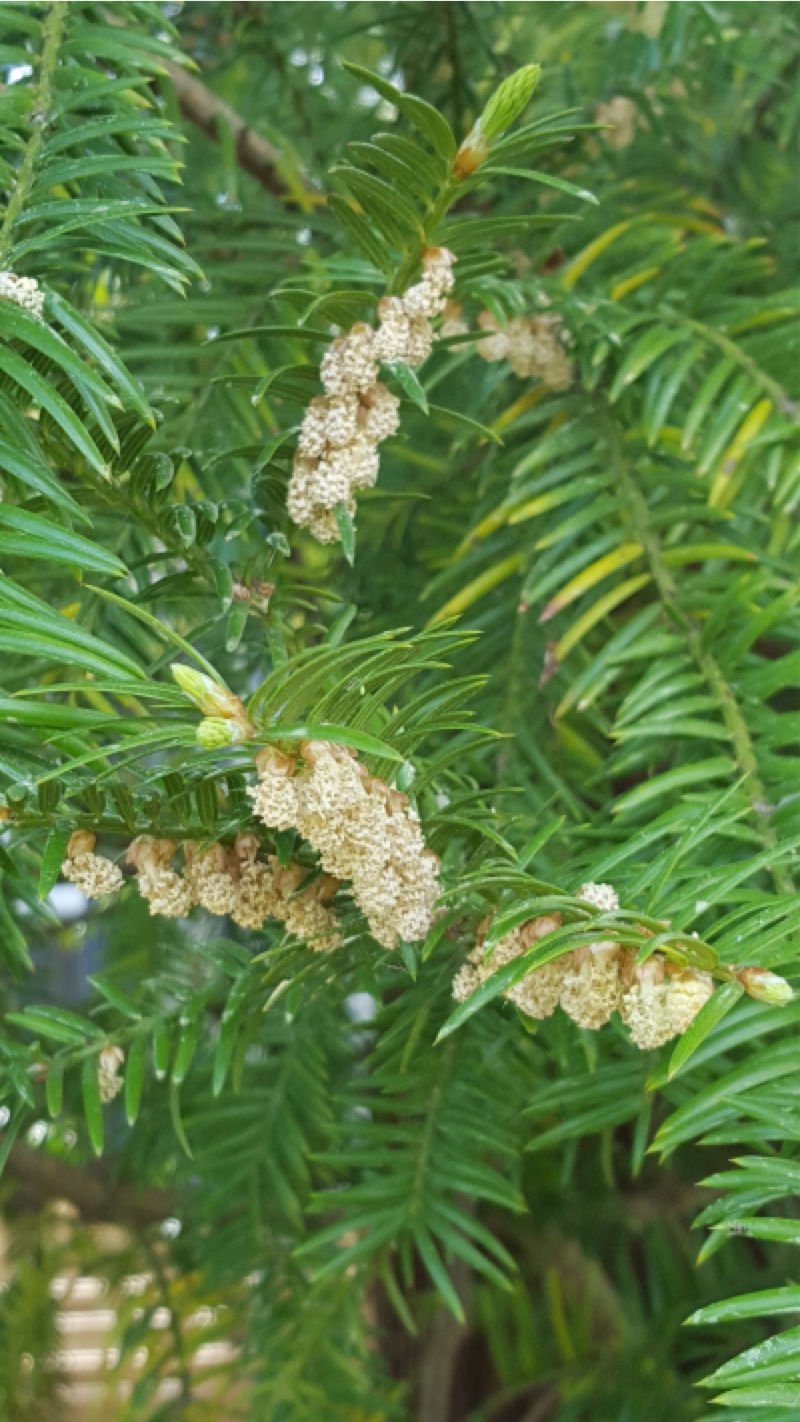
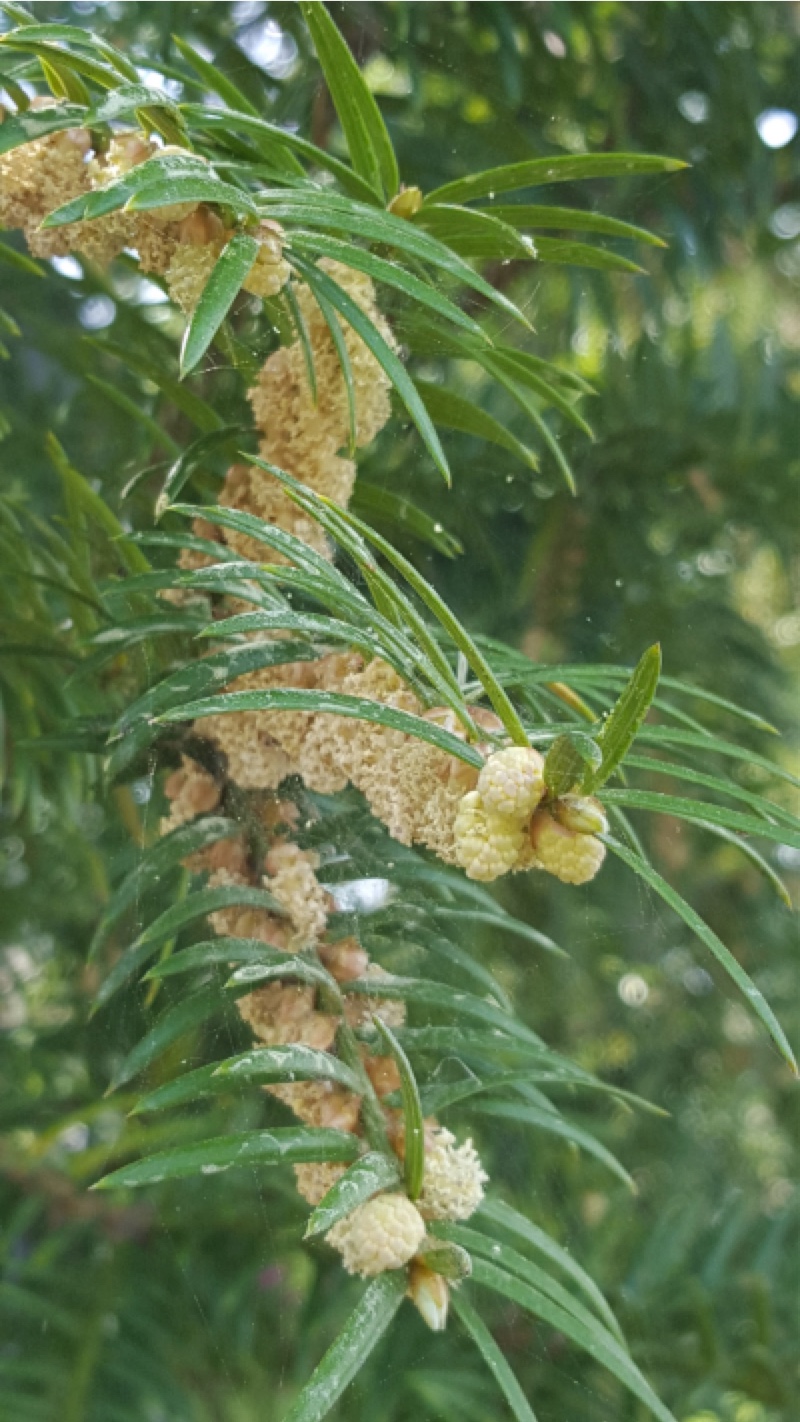
30 MARCH 2016: Clint Bancroft, Torreya Guardian of Greasy Creek TN, visited the sole remaining Columbus tree in March 2016 and took the above photos. These photos confirm that the tree is male. Also, an important learning is that Florida Torreya matures its pollen over a sequence of time — not all at once. This would appear to be a helpful survival strategy to maximize the possibility that pollen release would occur (a) when the weather and wind conditions are adequate for pollen dispersal, (b) that pollen might disperse over days in different directions as the wind shifts, and (c) that timing would overlap with a time span of receptivity of female trees.
Photo left: Trunk and branchlets of male tree. Notice how some branchlets bear a linear set of pollen structures; others bear structures only at the tips.
Photo center: Pollen is released before the vegetative buds (light green) at the branchlet tips fully open in the spring.
Photo right and below: These photos indicate that male structures open sequentially, with the last to open at the branchlet tip.
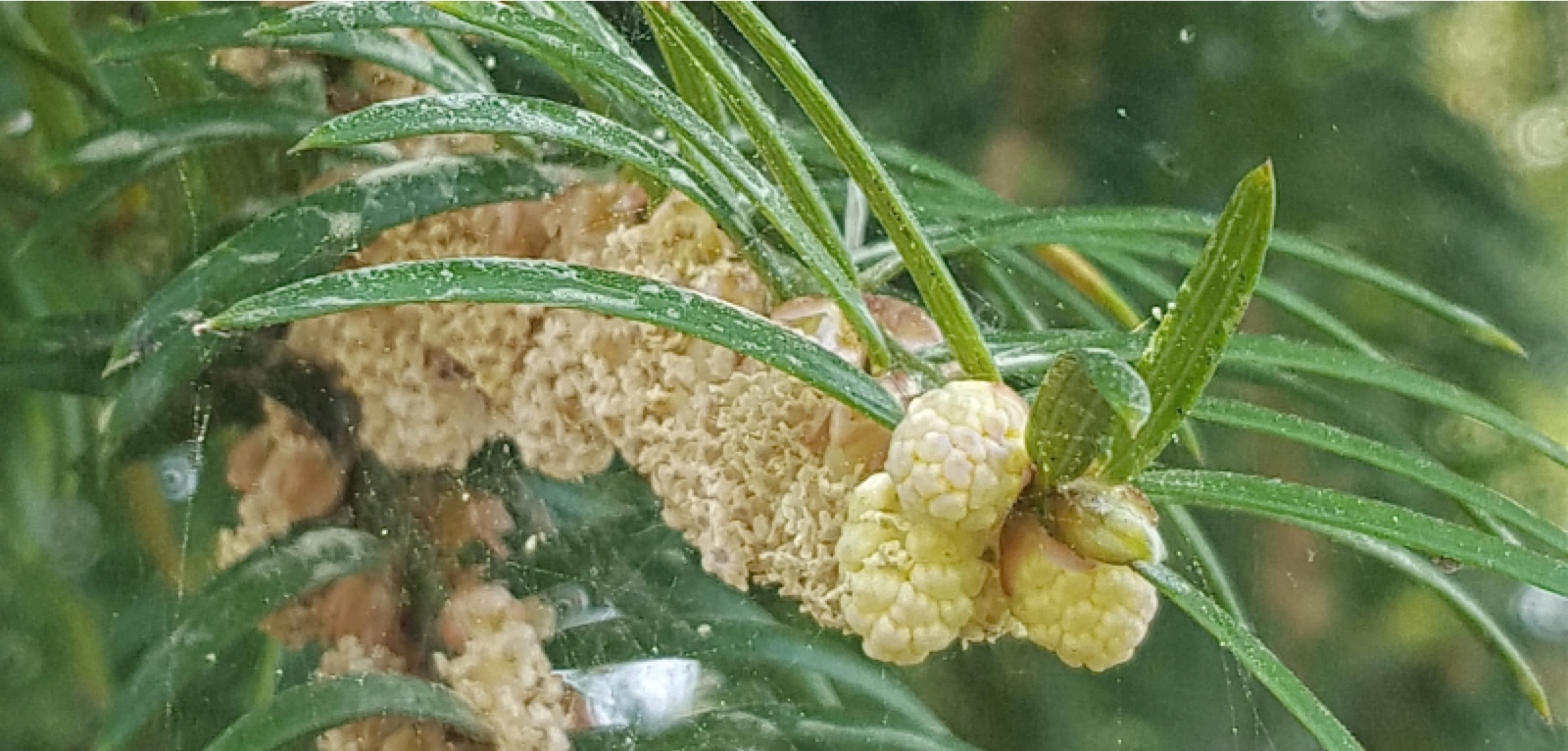
2015 VIDEO
"Ancient Florida Torreya in Columbus Georgia"
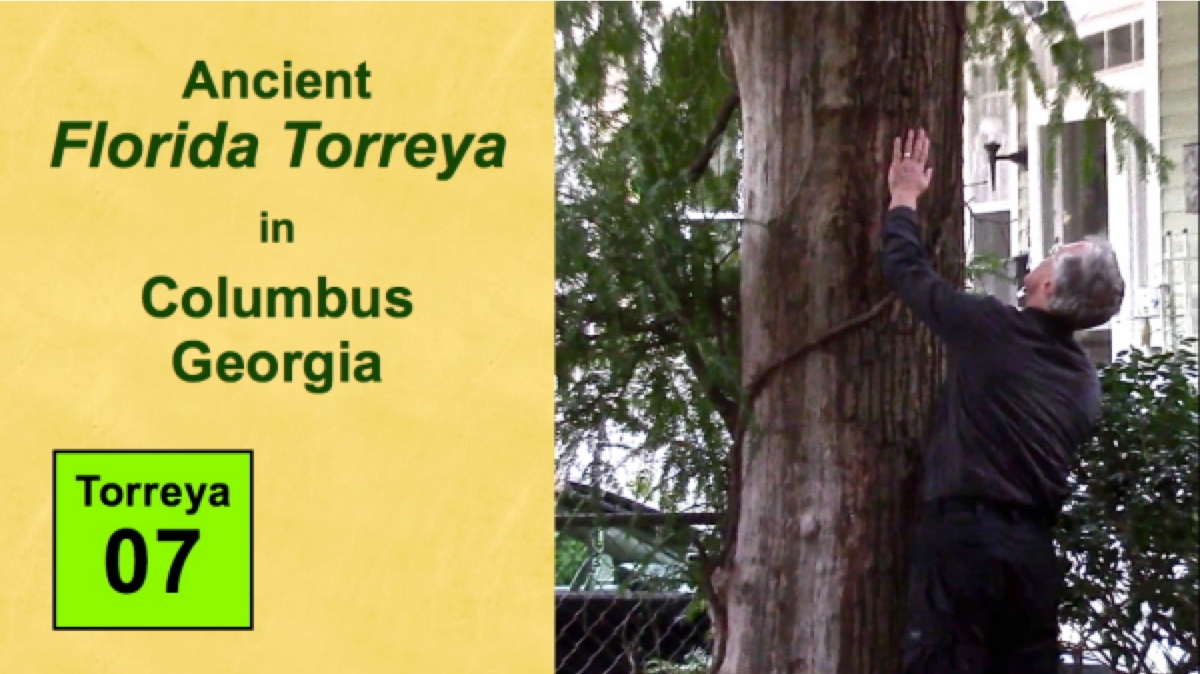
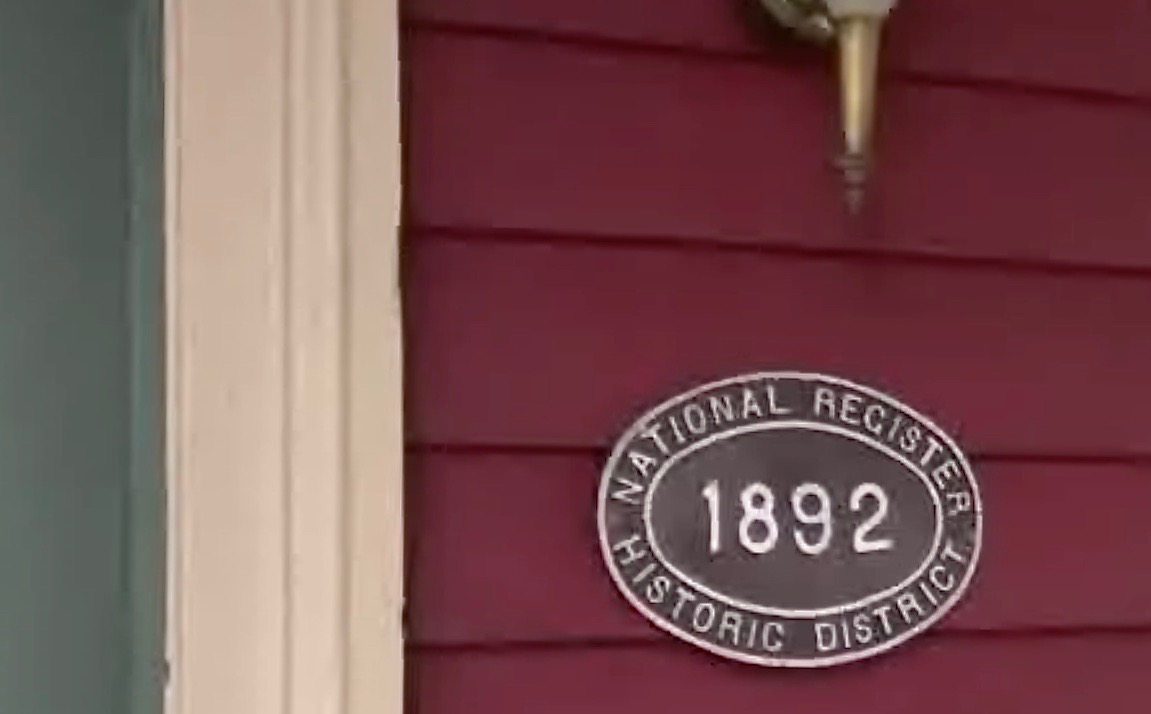
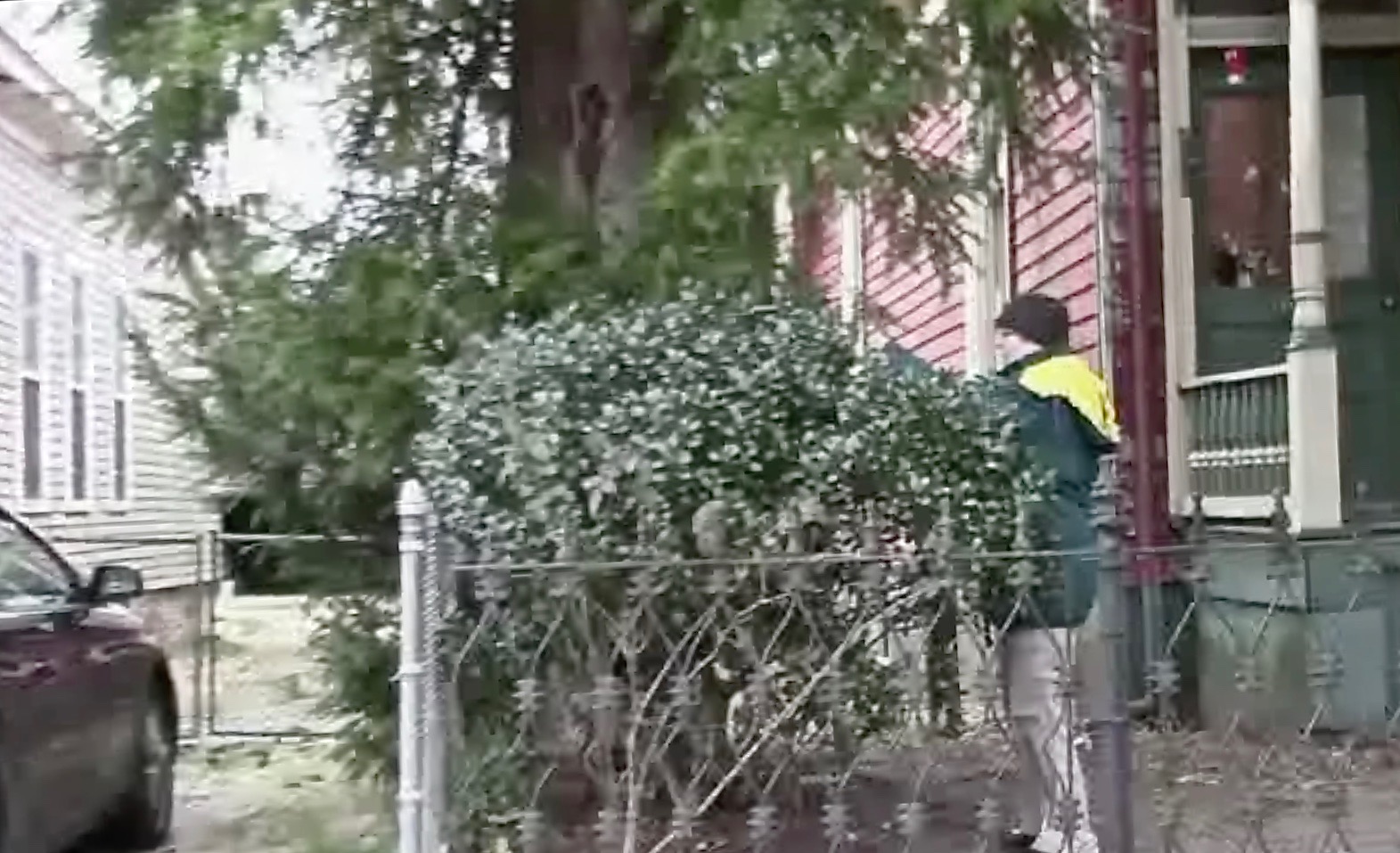
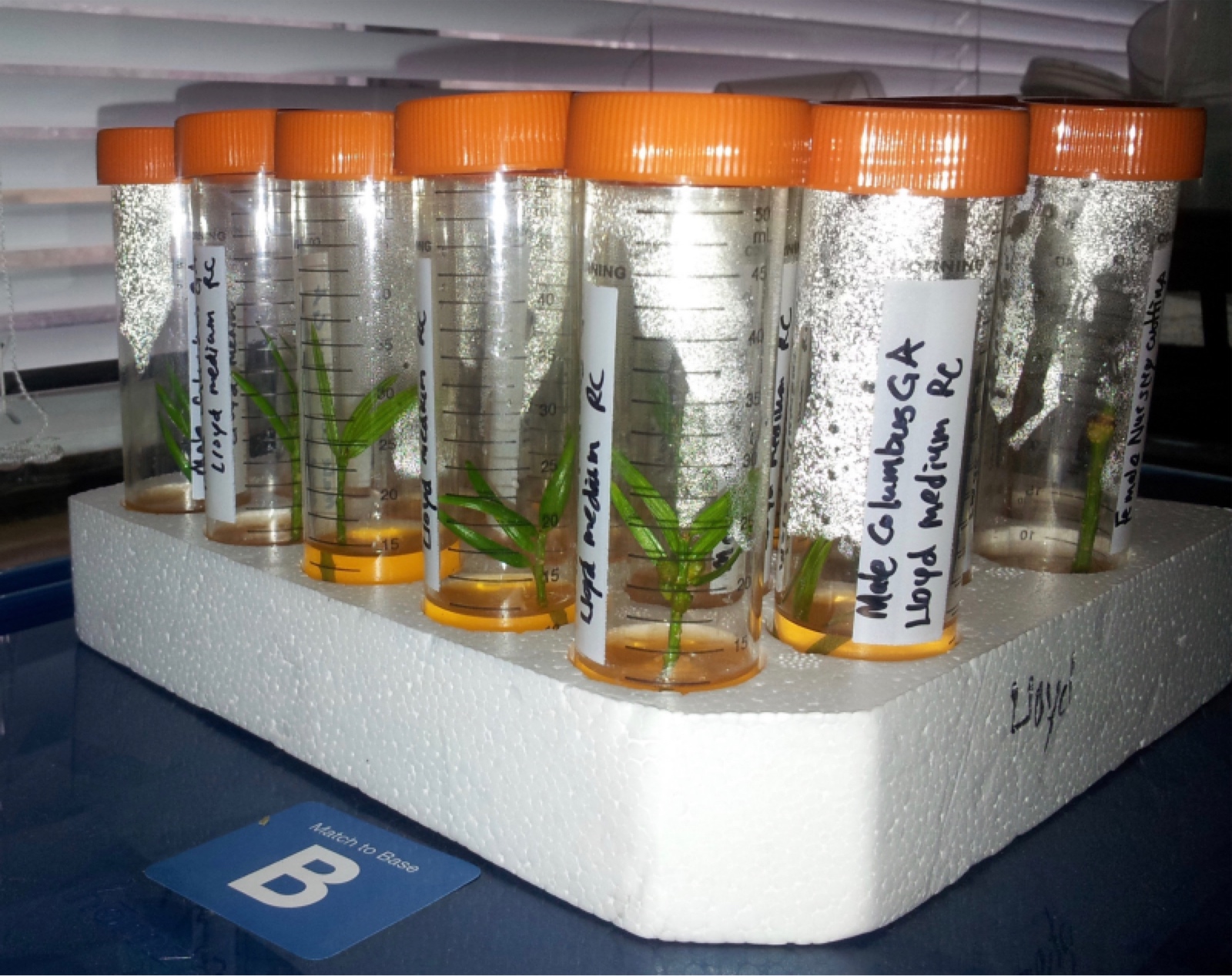 |
|
PHOTOS LEFT:
• Michael Dowd with tree
• 1892 address in "Historic District"
• Connie Barlow cutting branchlets
• Lab of Jeff Morris rooting branchlets
While visiting the famous sole remaining Torreya taxifolia in Columbus, Georgia, Connie Barlow was struck by its location right along a free-flowing section of the Chattahoochee River. The Chattahoochee is the main conduit between the peak-glacial plant refuge in n. Florida (along the Apalachicola River) and the southwestern Appalachian Mountains, where it would have lived in warmer times. "Might this ancient Torreya actually have been growing as a wild, native tree when the early white settlers built their first homes there?" asks Connie.
Connie collected several branchlets in order to try to produce clones from this ancient tree. Jeff Morris began by cutting them into 20 smaller pieces to separately root. The micropropagation method we're using is designed to root the terminal shoots of the cuttings, as opposed to creating thousands of plants from a single needle. By using only the 'terminal' shoots, we should be able to propagate individual seedlings that grow upright.
We look forward to distributing the rooted clones among our existing out-plantings, aiming to increase genetic diversity of populations that we hope will begin reproducing in the decades ahead.
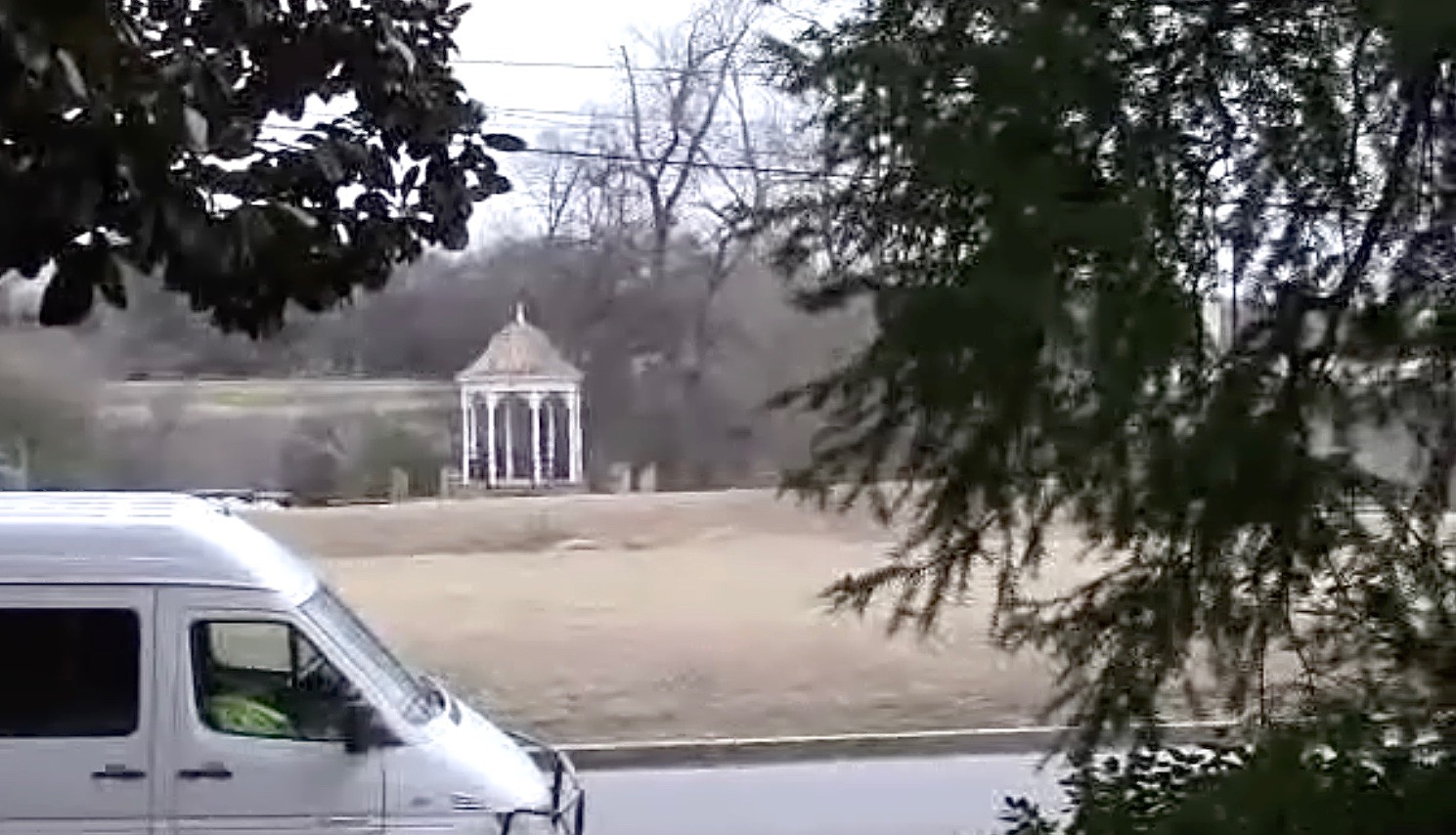
PHOTO ABOVE: View from the porch toward the city park along the Chattahoochee River (river visible to left of gazebo). Torreya branches foreground right.
|
Old Torreya in Columbus GA February 26, 2009 Fred C Fussell sent this email to Torreya Guardian Connie Barlow:
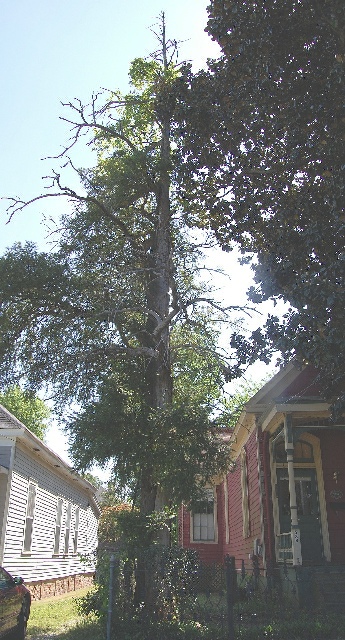 | |
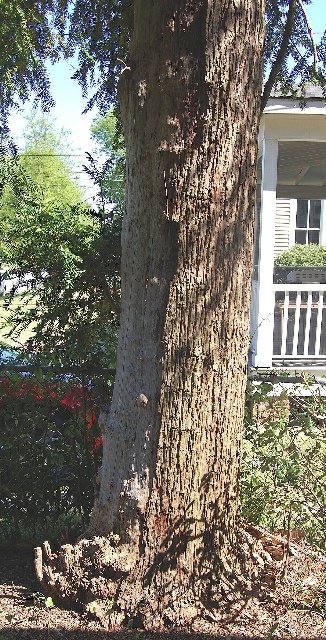 |
"At the very moment that we returned home today from a weekend visit to see our kids in Oxford, MS, we spotted a stranger on our front porch — one with Lafayette County, Mississippi, (Oxford) license plates on his car — knocking on our front door.
It turned out to be Edward Croom, Jr., PhD., who was here hoping to photograph our Torreya.
Ed had no clue that you and I had corresponded about the tree during the past two weeks. He was actually on his way to the Atlanta Botanical Garden to see other examples of Torreya and made a side trip to Columbus...."
|
"... As it happens, Ed and I have many, many other common interests and connections. However, he had seen and documented our tree and two others on our street in Columbus several years ago. Unfortunately, the other two were destroyed a few years ago. What a wild coincidence!"
• email from Mark Schwartz to Connie Barlow, 30 April 2009: "Yes, there used to be three trees there, two died in about 1995. This is the last one, as far as I know, in Columbus. It is nice to see Ed back thinking about Torreya."
• email to Connie Barlow from Leigh Brooks of Chattahoochee Fl in 2010:
"I had heard from knowledgeable botanists here in north Florida familiar with Torreya taxifolia that there were some trees in the historic district of Columbus, two homes is what I remember hearing. In May 2002 my sister Anathea visited and we did a road trip to see all the Torreyas we had heard of in the Southeast. We stopped at Columbus and searched the historic district very slowly street by street in the car, then a little on foot. Low and behold, we spotted a big tree! People at the
house were sitting on the porch, so I talked to them about it. They had no idea what it was, but were nice and let me take photos. I left them a brochure from Apalachicola Bluffs and Ravines Preserve that had a bit about Torreya. Just located the pics, black & white. They are labeled:
Torreya taxifolia >45'H approx 2'dbh lightning? Columbus, GA Historic Dst 538 Front Ave Photo: Leigh Brooks 05/02/2002
"So, I have seen the tree in Fred's yard, and yes, it's T. taxifolia! A large one indeed. I am pleasantly surprised it is still living. The top and one side looked dead, probably from lightning. Found my notes from the site. Some additional info. The residents said the dead branches happened in the last year. They had lived there 2 years and the tree was healthier back then. The remaining branches looked healthy. Some needles had fallen on the ground. It looked like it had like male flowers. There was yellow bellied sapsucker evidence (lines of small holes) throughout the trunk. Suckers and new growth were present. The trunk had some holes along the length, maybe where branches fell or were cut? There was a historic sign with year the house was built: 1898.
"I am fairly certain the tree and any others that may still remain in the historic district were planted when the homes were built. It is very close to the Chattahoochee River, and there was horticultural trade by steamboat back then. The age of the house and the size of the tree seem to reasonably correspond. The botanists here also say they were planted, though I can't remember the story."
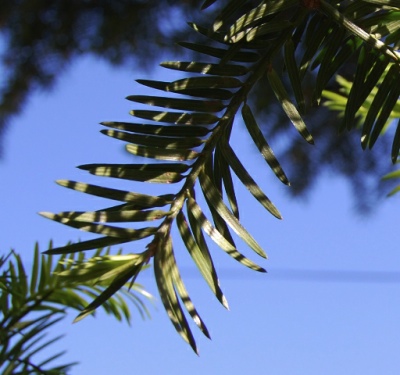
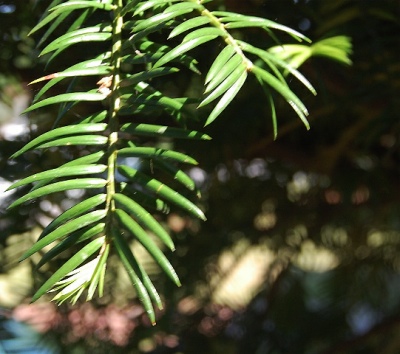
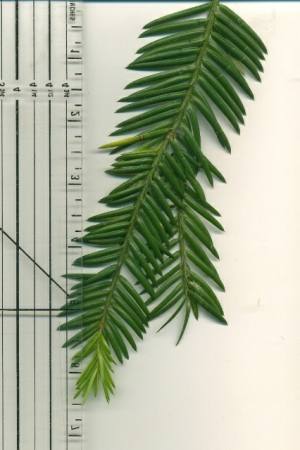
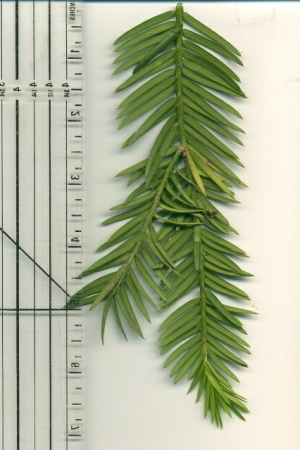
• Leigh Brooks emailed Torreya Guardians this correspondence from her colleague, Jerry Adams from Bainbridge GA, in May 2009:
"Stopped by Columbus, GA, the other day and two of the three torreya trees that grew on the river just south of downtown have been cut down. The remaining one is still living but very diseased. Next door neighbor said the house with the two trees changed hands about six years ago and they cut them down... I last saw the three trees in 2002 and of the two that got cut down, one was in really good shape. Mark Garland told me about the trees. He grew up in Columbus. Mark Garland is a respected botanist in Florida."
|
